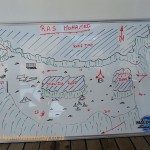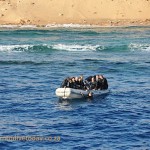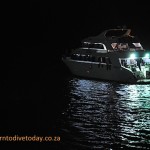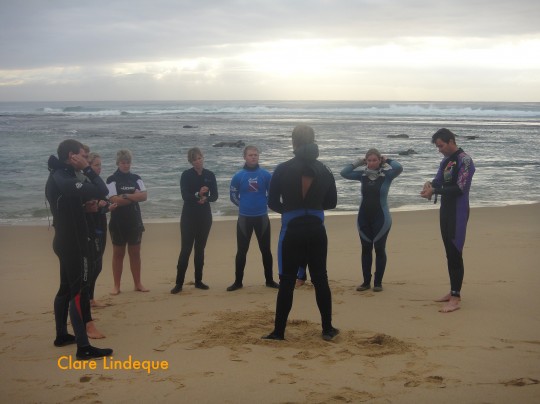Here are some photos to show you what it’s like to dive off a liveaboard. They were taken on our Red Sea trip in October. The centre of the diving activity was the dive deck at the lower level of the boat, at the back. There we hung our wetsuits, and we each had a cylinder and a box to keep our loose bits of gear in. We used the same cylinder throughout the entire trip, and the crew used the long hoses of the compressor to fill our tins right where they stood. We didn’t unbuckle our BCDs from our cylinders once.
A black (air) or green (Nitrox) tag around the neck of our cylinders indicated what gas we were diving with. We used Nitrox throughout. A numbered tag attached to the shoulder of our BCDs enabled the crew to keep track of who had returned from their dive. They also wrote down our dive times and maximum depths for each dive, and we signed those figures off each evening. This is in case of an accident – they know what your dive profile is for the week.
There were dives before breakfast, after breakfast, after lunch, and at night. On the first and last days we did three and two dives, respectively. I managed three dives a day. Christo did four! Most of us skipped a dive here and there, owing to fatigue, illness (don’t drink the tap or sea water, is all I can say), and general laziness! The briefings were detailed, with maps or slideshows to familiarise us with each dive site. We were told what creatures to look out for, and where they like to hide. For wrecks that could be penetrated, the dive guides explained the preferred route more than once.
After getting into our wetsuits we sat down in front of our kit, shrugged it on with the help of one of the crew, and walked down to the dive deck. There we either put our fins and mask on and giant strided into the water, or held our fins and climbed onto one of the Zodiacs to be driven a short distance to the dive site. This technique was used at busy sites where there were many other liveaboards already anchored, or locations where it wasn’t safe for the big boat to go.
To get out of the water we were either fetched by a Zodiac, or we returned to the back of the liveaboard and climbed up the dive ladders in our full kit. Helping hands were ready to assist us with our fins. We’d put our kit back, hang up our wetsuits, put cameras into the rinsing container on the dive deck, and then eat. Every dive was followed by food! And often, a nap.
At times strong currents had us hanging onto lines down to a wreck, and this also made getting back to the liveaboard a challenge at times. On one occasion the current was so strong that I wasn’t sure I’d make it from the line tied to the corner of the stern onto the ladder in the middle of the stern – a distance of two metres – without getting swept away. Some acrobatics and long arm stretches from Tony saved the day!
The process of diving off a liveaboard is far less strenuous than diving in Cape Town, which is why we could still walk after doing three or four dives a day. For one thing, the warm water means you get far less fatigued, and you use less air, too. The crew were extremely helpful on our trip, even zipping our wetsuits and providing soapy water when pulling on our thick cold water Trilastic suits seemed too much like hard work!




























